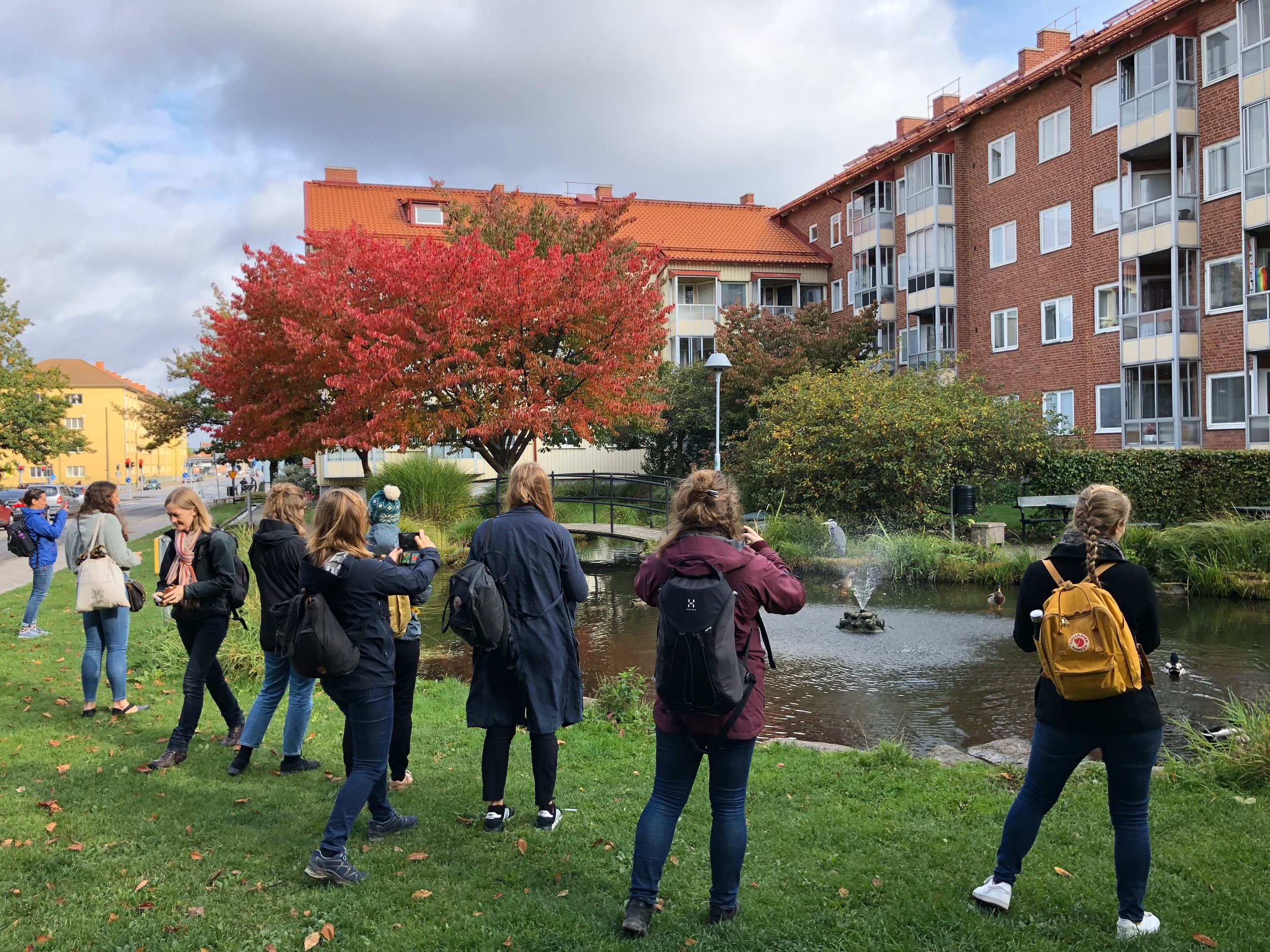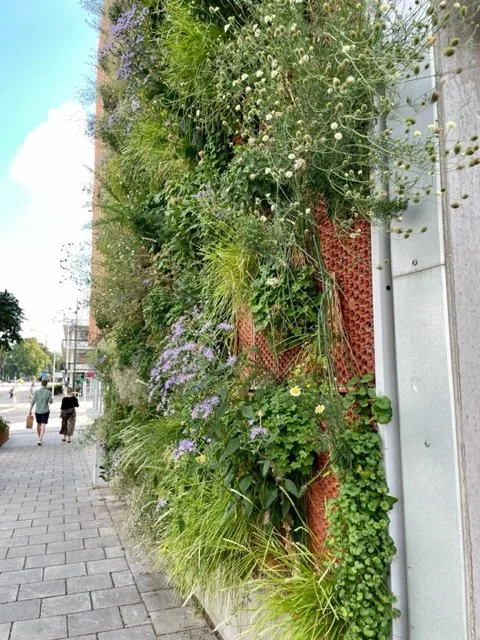The Scandinavian Green Roof Institute
Advertisement
The Scandinavian Green Roof Institute (SGRI) is located in Malmö in southern Sweden.
Since its inception in 2001, SGRI has been a research and competence center for urban blue-green solutions and ecosystem services.
SGRI supports the development of more sustainable cities by working towards an increased implementation of qualitative blue-green infrastructure that has the potential to strengthen urban ecosystem services and human well-being. Through a combination of research, consulting, education and inspiration, SGRI is active in increasing knowledge for functioning blue-green systems and green livable cities.
The saltwater canal in the exhibition area of Bo01, a very good example of blue green solutions. Photo: SGRI
History
Malmö, Sweden's third largest city and the fastest growing, has been affected by many floods over the centuries. The district of Augustenborg, which was built in 1948-1952 as a model area, changed over time into a neighborhood with both social problems and technical problems such as recurring basement flooding and a worn environment.
At the end of the 1990s, a process was therefore initiated that became the Ecocity Augustenborg, when many improvements were implemented such as open stormwater systems, green roofs, source sorting of waste and much more. The district won the UN World Habitat Award in 2010 for its urban sustainability initiatives. As part of this, Augustenborg's Botanical Roof Garden was also built on the premises of the Service Administration. At that time, it was the world's first and biggest research and demonstration facility for green roofs.
A total of 9,500 square meters of green roofs were constructed, of which 2,700 square meters are accessible to visitors through several hundred meters of footbridges at high level. A conference room for seminars and lectures was also built here. Since 2001, an estimated 50,000 visitors from all over the world have been able to visit the green roofs and open storm water systems in Augustenborg up close.
In 2001, the "Scandinavian Green Roof Institute" started to manage and run the work on Augustenborg's Botanical Roof Garden and at the same time organize study visits to the district. The goal was to create a node for scientific knowledge exchange about green roofs on an international level, and to spread knowledge about integrated, open stormwater management systems. The institute is owned by an association, the Scandinavian Green Infrastructure Association, which provides for the Scandinavian Green Roof Award to various green roof projects around Scandinavia.
More Relevant Than Ever
Multifunctional use of the common areas is essential in order to use blue green solutions in our dense cities. Photo: SGRI
Now, after just over 20 years, time and development have started to catch up. There is an established discourse among both politicians and municipal planners about urban ecosystem services and the need for climate adaptation with blue-green solutions. However, the need for knowledge is greater than ever, which is reflected in the institute's expanded activities with, in addition to study visits and lectures, also training and counseling. The institute still actively participates in various research projects aimed at climate adaptation with various blue-green solutions.
In 2014, Malmö was hit by a torrential downpour which statistically should only happen every 360 years. Over 120 mm (4.75 inches) of rain in just 6 hours put the entire city more or less under water. But thanks to the open stormwater systems, which involve the use of many infiltration surfaces on the ground, as well as green roofs, the district of Augustenborg escaped the storm without experiencing any flooding, almost completely unnoticed. The experiences from this approach to stormwater management have become more and more relevant in cities, as extreme weather as a result of climate change becomes more and more common. SGRI's services as, among other things, a communication link between researchers, owners and suppliers, as well as green operational staff within blue-green solutions which are often in demand.
Advertisement
Blue-Green Solutions and Ecosystem Services
Blue-Green Solutions are vegetation systems designed with consideration for both the green (vegetation) and the blue (water management). They are often made multifunctional so that they contribute to both stormwater management, biological diversity and have aesthetic values, but they also create pleasant places to stay at, areas for recreation or social activities. It is important to see the whole in a systemic perspective. This grants for a sustainable, resilient and healthier city. At the Eco-City in Augustenborg, we use a combination of green roofs, porous paving, rain gardens, tree cover, bioswales, ponds and a large infiltration trench in a park to reduce flooding and provide amenity space for residents.
More than 50 000 people from all over the world have visited Malmö and Augustenborg since 2001 to learn more about bee green solutions. Photo: SGRI
Study Visits
Over the years, the study visit activity has grown from only Augustenborg with stormwater solutions and green roofs, to the fact that we now go around the whole of Malmö and the sister city of Copenhagen to study different types of blue-green solutions. Cycling is very popular because it gives flexibility and an opportunity to get really close to the different solutions that cities have used to tackle climate change. In addition to green roofs and walls, we visit various rain gardens, swales, tree plantings in structural soil etc.
Research projects
SGRI acts as project manager and is active in various research projects within blue-green infrastructure, which means that we are always up to date with the latest research and new innovations. A few examples:
Blue Green City Lab
Blue-green infrastructure such as green roofs, green walls and rainbeds, made as adaptations in an already built environment along with a new way of thinking in planning new buildings, play an important part in making the city more resilient and reducing the problems when torrential rains and heat waves hit us. At the same time, they can provide restful and beautiful places for residents to stay and contribute to biological diversity.
Blue Green City Lab is a collaboration between actors in sustainable urban development and blue-green solutions that together drive the issues forward. BGCL is part of research and innovation projects and offers advice on what kind of solutions are suitable for which needs combined with information about what products and solutions are available on the market.
Advertisement
Green Sponge Buildings in Scandinavia
A green wall, installed on a parking garage in the city center of Malmö, allows people to get really close to the greenery. Photo: SGRI
An Interreg-funded project that will investigate whether living, green walls can be a solution to tackle the challenges of increased rainfall, increasing illness and decreasing biodiversity.
In Scandinavia, we are expecting wetter winters and drier summers in the future, with more frequent and heavier precipitation. The changing climate burdens our society both financially, socio-economically and health-wise.
The project will contribute to climate adaptation by investigating if buildings can form part of the solution in Scandinavian cities, with a focus on green walls, which have the potential to store and delay rainwater, contribute with experience values and create new habitats for plants, birds and insects.
Education
Within the research projects, over the years we have developed seminars, lectures and shorter courses on green roofs and other blue-green solutions. In recent years, we have focused further on education and are now contracted by several educational companies where we step in as course leaders regarding longer courses regarding green infrastructure, ecosystem services and nature-based solutions and blue-green-gray solutions. It has become clear over the years that a lot of skill development is required for cities to adapt and become more resilient, while at the same time there is a lack of knowledge in many areas.
Counseling
Although many municipalities and property owners are now aware of the need for blue-green solutions, the knowledge to implement them is often lacking. There we support different types of expertise. Because we have a foot in research and are up-to-date on innovative blue-green system solutions, we can help achieve visions within blue-green solutions. We can produce various desired reports or offer expert support and expertise to coordinate and ensure sustainable green and blue solutions in various projects.
Future
With prevailing climate change and consequent extreme weather such as heat waves, long dry spells and torrential downpours, it is necessary to implement more blue-green solutions in our cities to adapt to new local climates. SGRI's services, to show and explain how blue-green solutions work, are therefore something in a rising demand.
Looking back, the Ecocity of Augustenborg was and still is a great and unique example of climate adaptation. Now we need to look ahead, into the future, and implement the experiences and lessons learned in a greater context.
Advertisement
Helen Johansson, CEO at Scandinavian Green Roof Institute, gives lectures and courses about blue green urban solutions and has a special interest of green roofs.
Solar green roof integration article.
See the SGRI website.






